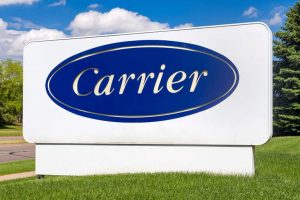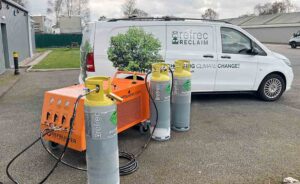A2L refrigerants – myths and realities (Pt 1)
14th May 2016
In the first of a series of articles, Karl Richardson of Logicool Air Conditioning & Heat Pumps presents an unbiased look at the myths and realities of the new “mildly flammable” A2L gases.
Having spent the best part of the last six months researching R32 and A2L refrigerants and also having successfully trained a lot of our customers on this subject I think it is time to deliver this knowledge to the general trade in the most relevant and compact way possible.
The air conditioning industry is facing a huge step-change in the next few years.
From 2015, the EU is reducing CO2 emissions that are directly produced from the manufacture of refrigerants (it seems that we have given up on trying to prevent leaks). In previous years we have seen CFCs and HCFCs banned completely. The new regulations encourage innovations by capping the potential CO2 emissions in stages between 2015 and 2030.
CO2 emissions from refrigerants are directly related to global warming potential (GWP). Every refrigerant has a GWP number. The higher the number, the higher the CO2 emissions, the more effect that any product leaked to atmosphere has on the environment.
By assembling data from all refrigerant producers, importers etc between 2009 and 2012, the EU has imposed a baseline CO2 figure of 183 million tonnes of consumption.
The refrigerant producers/importers within the EU are now issued with a CO2 emissions quota on an annual basis. They can only produce more product by encouraging the use of refrigerants with a lower GWP. They cannot manufacture more than their quota. This promotes innovation in that the EU is not restricting sales but potentially encouraging growth but only via lower-GWP product.
Phase down
Remember that the European phase-down started in 2015. This was 100% of the baseline figure. The current phase-down for 2016 is 93% of the baseline. By 2030 we need to be at 21% of the baseline. This means an 81% reduction or 34.77 million tonnes of CO² compared to the 2015 baseline of 183 million tonnes. The challenge is to engage with a growing market by producing more product but emitting less CO² to the atmosphere.
The reality is that 2014 saw a CO2 consumption figure much greater than the actual benchmark. This can be put down to potential factors such as a significant increase in imports before the benchmark began in 2015 and restored confidence in the economy.
Of greater concern are the following facts and figures:
• The economy is much more buoyant now than when the benchmark data was analysed. Therefore we are, in reality, in a much deeper phase-down if the typical market consumption is already on the increase and in excess of the predicted actual product equivalent of 183 million tonnes
• 2017 – 37% reduction (115.29 million tonnes)
• 2024 – 69% reduction (56.73 million tonnes)
Simple mathematics tells us that if we do nothing then we will have a real supply issue in 2017.
Progress
Some industries that use refrigerants are already progressing with lower GWP alternatives. One well documented example is the automotive market. This particular industry is transferring to the HFO R1234yf which has a GWP of just 4. Considering that its predecessor R134a had a GWP of 1430 this means that as a rule of thumb we can charge 1428 new cars with R1234yf to achieve the same GWP or CO2 impact as one car with R134a.
Products such as air-to-water heat pumps and chillers are also already making the leap to lower GWP alternatives, although this is not as advanced as the automotive market.
This is comforting news for other industries such as the one that I operate in. It gives us a little bit of breathing space.
Packaged air conditioning is slow to react to the required changes by way of launching product. The reasons are complex but are mainly down to re-publishing of existing legislation which I will cover in another post. However, the following are the principle reasons for the delay:
• Some EU countries currently prohibit the use of flammable refrigerants in commercial applications (Spain, Italy, France)
• Chillers, air to water and automotive systems are fixed charge, fixed capacity systems. Packaged splits and VRF have variables such as differing capacities, pipe sizes and pipe runs. This means that the design and application of the product are different and need more thought from an r&d perspective.
• The total allowable refrigerant charge will be limited in packaged air conditioning products and this is likely to affect the range of products available.
R32
Changes to legislation are not moving as quickly as we would like. However, it seems that most Japanese manufacturers have confirmed pre-2017 launches for RAC products. This means small commercial/domestic systems up to and including 7kW. Some manufacturers have confirmed packaged/commercial air conditioning products “sometime in 2017”. Expect all the main players to confirm their official announcements soon. Two of our manufacturers have commercial product (up to 14kW split systems) confirmed for 2017. At Logicool we already have R32 product installed and available in 2.5, 3.5 and 5kW flavours.
All of these packaged air conditioning products will be charged with refrigerant R32. This is a mildly flammable refrigerant but there is no need to panic.
In the UK, if you or your engineers have City & Guilds 2079 and/or a valid F-Gas certificate then you are qualified to use A2L refrigerants including R32.
The mild flammability is only an issue if you do not understand why and how. The products have a flammable logo on the nameplate so awareness and management are key to this. I will cover this in a future post.
R32 has a GWP of 675 compared to R410A which has a GWP of 2088. This means that our refrigerant suppliers can continue to supply our specific industry with refrigerant for the next few years.
What we as an industry need to do is focus more on containment and promote good practice. Keeping refrigerant where it should be is the ultimate goal. Expect more changes from 2020 onwards as R32 may not be the long-term solution for all products.
What is here to stay is A2L, all of which are mildly-flammable refrigerants. This is a culture change that we need to get to grips with now.
CPD Approved training on A2L refrigerants is available from Logicool at www.logicool-ac.com.
Call 01283 218277 or email [email protected] for more information.
Related stories:
https://www.coolingpost.com/blog-posts/a2l-refrigerants-myths-and-realities-pt-2/









